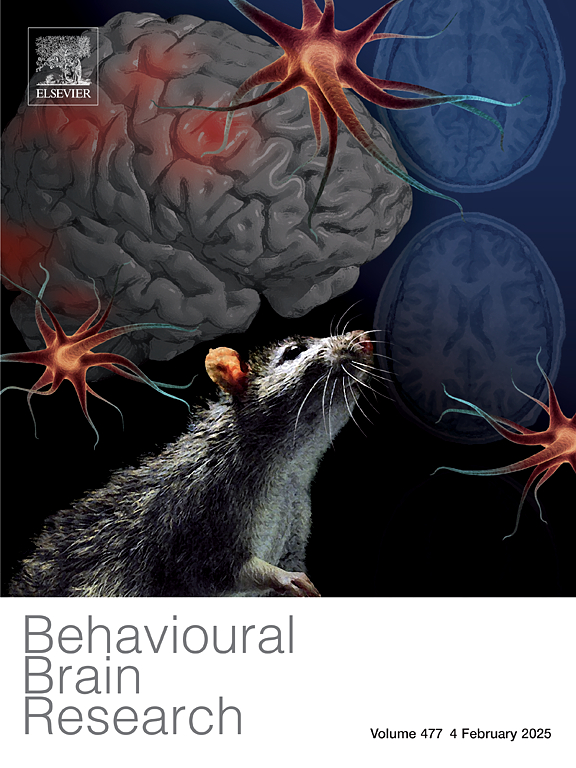AIM2 mediated neuron PANoptosis plays an important role in diabetes cognitive dysfunction
IF 2.6
3区 心理学
Q2 BEHAVIORAL SCIENCES
引用次数: 0
Abstract
The increasing global aging population has led to a rise in diabetic cognitive dysfunction (DCD), a common complication of diabetes that significantly impacts the health of elderly individuals. Neuronal death is a key factor in cognitive impairment, with studies showing interactions between cellular pyroptosis, apoptosis, and necroptosis in the development of neurodegenerative disorders. This has led to the concept of PANoptosis, where these pathways work together to cause cell death. High glucose levels can induce neuronal damage and cognitive dysfunction in rats, leading to various forms of programmed cell death. It is hypothesized that high glucose can trigger neuronal PANoptosis, resulting in cognitive dysfunction. AIM2, an upstream regulator of PANoptosis, is closely associated with the pathogenesis of DCD. In DCD, dysregulated glucose metabolism induces the release of mitochondrial DNA (mtDNA), which acts as a ligand to activate the cell membrane-bound DNA sensor AIM2. Upon activation, AIM2 oligomerizes and recruits a caspase recruit domain (ASC), forming a complex that activates caspase-1. Caspase-1 activation subsequently triggers the production of pro-inflammatory cytokines, induces pyroptosis, and mediates apoptosis, necroptosis, and PANoptosis in neurons through signaling crosstalk. Understanding the pathophysiological mechanism of AIM2-mediated neuronal PANoptosis in DCD development can aid in early diagnosis and identify new therapeutic targets.
AIM2介导的神经元PANoptosis在糖尿病认知功能障碍中起重要作用
全球人口老龄化加剧导致糖尿病认知功能障碍(DCD)的增加,糖尿病是糖尿病的一种常见并发症,严重影响老年人的健康。神经元死亡是认知障碍的一个关键因素,研究表明,在神经退行性疾病的发展中,细胞焦亡、凋亡和坏死亡之间存在相互作用。这导致了PANoptosis的概念,即这些通路共同作用导致细胞死亡。高葡萄糖水平可诱导大鼠神经元损伤和认知功能障碍,导致各种形式的程序性细胞死亡。据推测,高糖可引发神经元PANoptosis,导致认知功能障碍。AIM2是PANoptosis的上游调控因子,与DCD的发病密切相关。在DCD中,葡萄糖代谢失调诱导线粒体DNA (mtDNA)的释放,mtDNA作为配体激活细胞膜结合的DNA传感器AIM2。激活后,AIM2寡聚并募集caspase募集域(ASC),形成激活caspase-1的复合体。Caspase-1的激活随后触发促炎细胞因子的产生,诱导焦亡,并通过信号串扰介导神经元的凋亡、坏死和PANoptosis。了解aim2介导的神经元PANoptosis在DCD发展中的病理生理机制有助于早期诊断和发现新的治疗靶点。
本文章由计算机程序翻译,如有差异,请以英文原文为准。
求助全文
约1分钟内获得全文
求助全文
来源期刊

Behavioural Brain Research
医学-行为科学
CiteScore
5.60
自引率
0.00%
发文量
383
审稿时长
61 days
期刊介绍:
Behavioural Brain Research is an international, interdisciplinary journal dedicated to the publication of articles in the field of behavioural neuroscience, broadly defined. Contributions from the entire range of disciplines that comprise the neurosciences, behavioural sciences or cognitive sciences are appropriate, as long as the goal is to delineate the neural mechanisms underlying behaviour. Thus, studies may range from neurophysiological, neuroanatomical, neurochemical or neuropharmacological analysis of brain-behaviour relations, including the use of molecular genetic or behavioural genetic approaches, to studies that involve the use of brain imaging techniques, to neuroethological studies. Reports of original research, of major methodological advances, or of novel conceptual approaches are all encouraged. The journal will also consider critical reviews on selected topics.
 求助内容:
求助内容: 应助结果提醒方式:
应助结果提醒方式:


